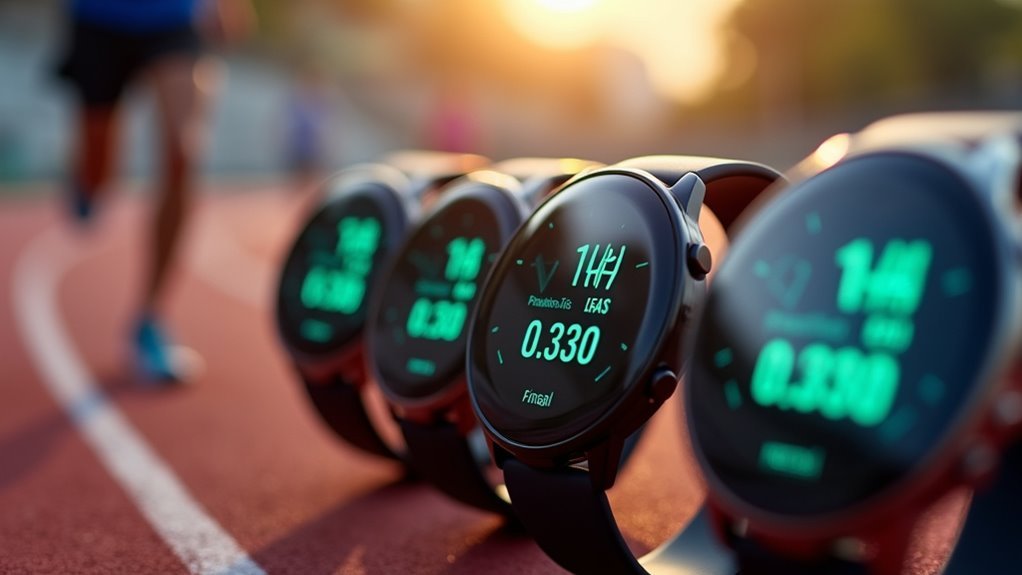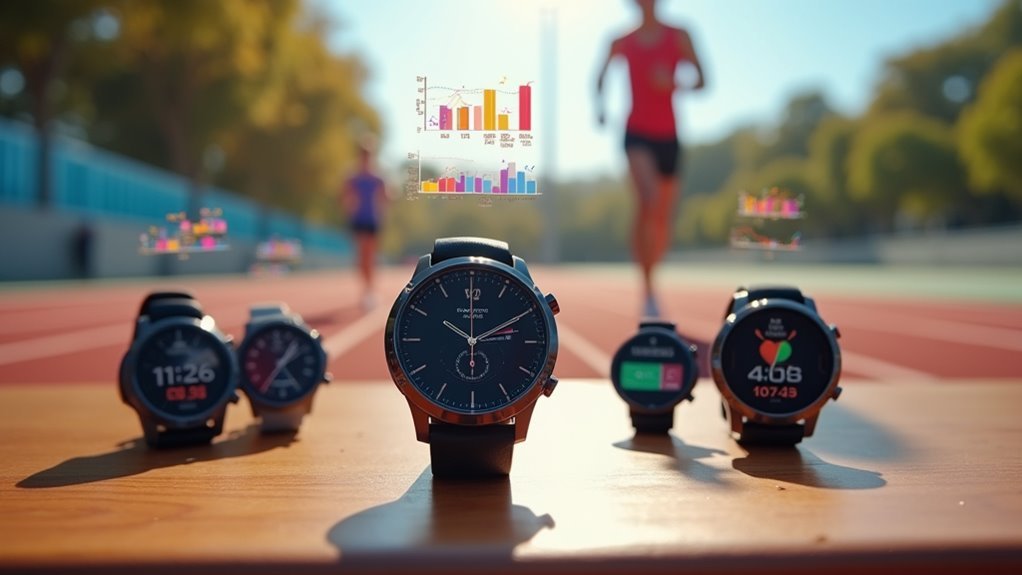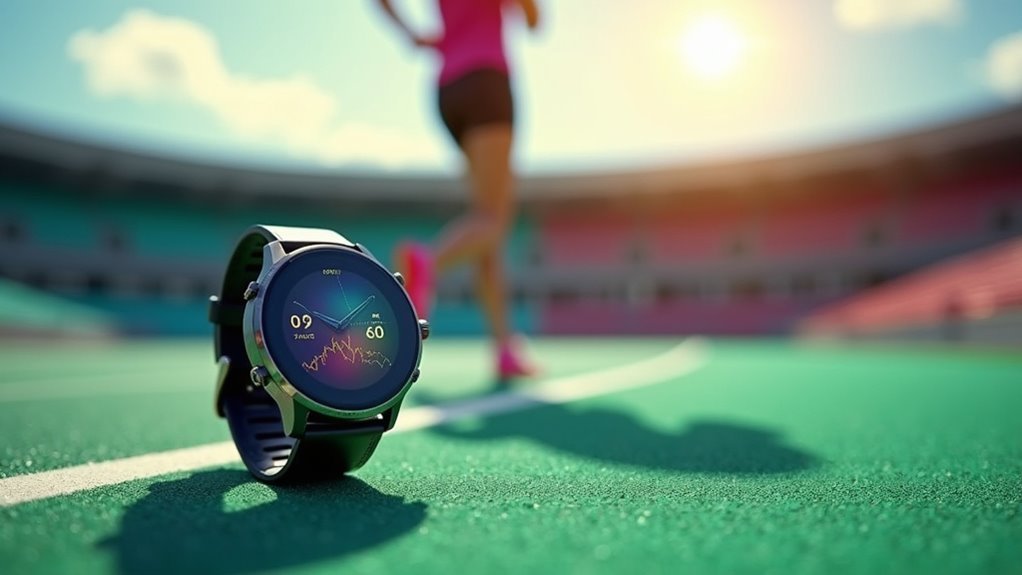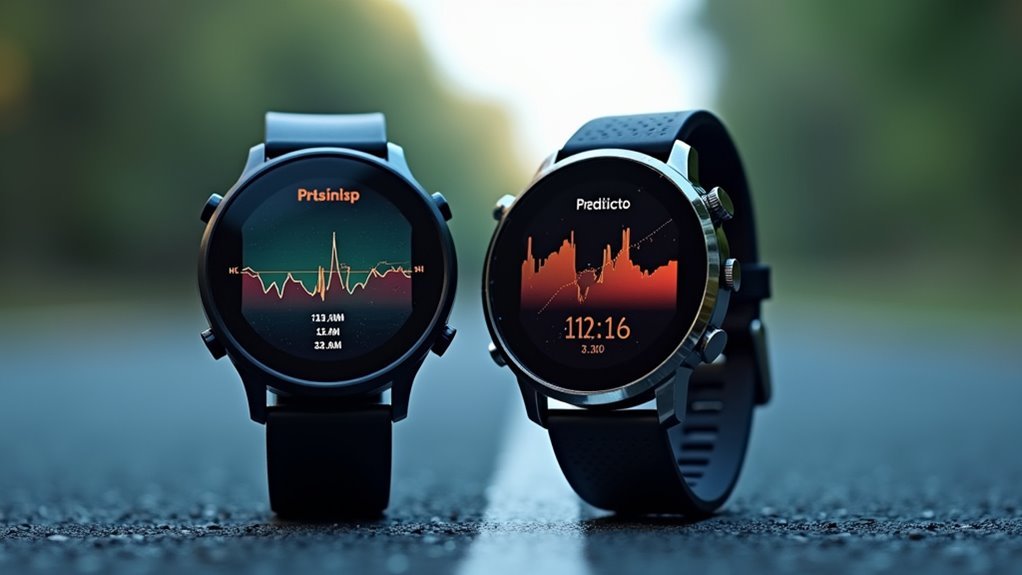You can expect impressive accuracy from modern running watches, with most achieving 95%+ correlation rates and error rates under 3% for 5K to half marathon distances. Premium models like Garmin’s Fenix series excel at shorter distances, while brands differ in their strengths—Garmin focuses on elevation precision, Coros delivers superior GPS performance, and Apple prioritizes user-friendly interfaces. Your prediction reliability depends on consistent training data, VO2 max calculations, and proper calibration to access these watches’ full potential.
How Accurate Are Current Running Watch Race Predictions

When you’re planning your next race, you’ll be relieved to know that current running watch predictions demonstrate remarkable accuracy across multiple distances.
Research involving 154 amateur runners reveals that smartwatch predictions achieve correlation coefficients of at least 0.95 for 5K, 10K, and half marathon distances, indicating very strong agreement between predicted and actual times.
Smartwatch race predictions show remarkable 95%+ correlation with actual finish times across 5K, 10K, and half marathon distances among amateur runners.
You can expect error rates under 3% across these distances, with accuracy exceeding 97% based on intraclass correlation coefficients.
The predictions work best for shorter distances, showing minimal bias for 5K races. Premium models like the Garmin Fenix 8 offer comprehensive race time predictor features alongside their advanced training metrics.
Since these results reflect accumulated training data from at least six weeks of wear, you’ll find the predictions particularly reliable for setting realistic race goals and structuring your training preparation.
Key Factors That Impact Prediction Reliability
Despite these impressive accuracy rates, several factors can greatly influence how reliable your running watch’s race predictions will be.
Your watch’s VO2 max calculation and heart rate data accuracy directly impact prediction quality, while algorithmic errors can lead to overestimated performance expectations.
Environmental conditions like weather, terrain, and temperature greatly affect your actual race performance but aren’t always factored into predictions.
Your physical state—including stress levels, injuries, recovery status, and mood—plays a vital role that your watch can’t fully detect.
Training consistency and recent performance trends help improve accuracy, but your watch model’s sensor technology and data collection capabilities vary greatly. Training consistency is particularly important since fluctuations in your running routine can significantly impact the reliability of your watch’s predictions.
Finally, proper calibration and user input enhance reliability, while nutritional factors and adaptation to specific race distances remain challenging variables for any device to predict.
Comparing Prediction Models Across Major Brands

Each major running watch brand employs distinct prediction algorithms that can greatly impact your race time forecasts.
Garmin prioritizes elevation accuracy, often reporting higher elevation gains than competitors, making it popular among serious runners for reliability.
Coros excels in challenging environments like deep canyons, consistently delivering strong GPS performance where others struggle.
Suunto’s “Snap to Route” feature combines GPS with barometer data, optimizing route following through GPX files for enhanced accuracy.
Apple focuses on seamless integration and user-friendly interfaces, though it may not match specialized running watches’ GPS precision.
Wahoo emphasizes running-specific features with customizable data screens.
Polar utilizes unique features like the Leg Recovery test to provide tailored insights that enhance training effectiveness and race predictions.
Understanding these algorithmic differences helps you choose a watch that aligns with your specific training needs and racing conditions.
Device Features That Enhance Forecasting Performance
Several core device features work together to transform your running watch from a simple tracker into a sophisticated race forecasting tool. Your watch’s VO2 max estimation serves as the foundation, measuring your aerobic fitness to anchor race predictions.
GPS tracking provides precise distance measurements, while training data analysis examines your recent performance trends to refine predictions.
Sleep and recovery monitoring adds another layer by evaluating your overall readiness, since fatigue directly impacts race performance. Prediction accuracy improves significantly when you complete multiple longer activities before your targeted race event.
Your watch integrates biometric data like heart rate variability to create a thorough fitness picture. Advanced heart rate monitoring techniques deliver more accurate fitness evaluations, while machine learning algorithms process vast datasets to improve prediction accuracy.
Cloud-based processing enables complex analysis that wouldn’t be possible on your device alone.
Future Improvements in Race Time Estimation Technology

As running watch technology continues evolving, breakthrough improvements in algorithmic modeling are pushing race prediction accuracy to unprecedented levels.
You’ll soon experience prediction errors dropping below 0.1% for 10K races, with machine learning models incorporating your heart rate variability, perceived exertion, and personalized physiological metrics.
Enhanced sensor fusion will combine underwater-capable heart rate monitors, Bayesian-powered stride sensors, and improved GPS technology for thorough data collection.
Cloud computing will enable real-time model updates using aggregated community data, while environmental variables like elevation, weather conditions, and terrain type will refine your race forecasts.
Expect adaptive feedback systems that’ll dynamically adjust your pacing strategies during races and provide personalized workout recommendations based on continuously improving predictions tailored specifically to your performance patterns. Current studies demonstrate that amateur runners can achieve highly accurate race predictions with error rates under 3% when using smartwatches consistently over extended periods.
Frequently Asked Questions
How Often Should I Update My Running Watch Firmware for Better Predictions?
You should update your running watch firmware whenever prompted by the manufacturer. Regular updates fix bugs, improve GPS accuracy, and enhance prediction algorithms, so don’t delay installing them for ideal performance.
Can Running Watches Predict Race Times for Trail Runs and Ultra Marathons?
Running watches can predict trail and ultra-marathon times, but they’re less accurate than road race predictions. You’ll face challenges with terrain variability, environmental factors, and limited ultra-specific training data affecting reliability.
Do Weather Conditions Like Heat and Humidity Affect Race Prediction Accuracy?
Yes, heat and humidity greatly affect your race prediction accuracy. Your watch’s algorithms may not account for temperature’s 40% performance impact or humidity’s 26% influence, making predictions less reliable in extreme weather conditions.
Should I Trust My Watch’s Prediction if I’m Returning From Injury?
You shouldn’t trust your watch’s race predictions when returning from injury. Limited recent data compromises accuracy, and watches can’t account for actual physiological recovery or reduced muscle strength after injury.
How Do Running Watch Predictions Compare to Coaching-Based Race Time Estimates?
Your watch’s algorithmic predictions typically achieve 97% accuracy for shorter distances, while coaching estimates consider race conditions and individual feedback. Coaches better account for weather, course difficulty, and nutrition factors that watches can’t predict.
In Summary
You’ll find that running watch race predictions have improved considerably, but they’re still not perfect. Your best bet is choosing devices with advanced metrics like VO2 max, training load, and recovery data. Don’t rely solely on any single prediction—use it as a guide while considering your recent training, health, and race conditions. As technology advances, you can expect even more accurate forecasting that’ll better account for individual variables and real-time physiological changes.





Leave a Reply